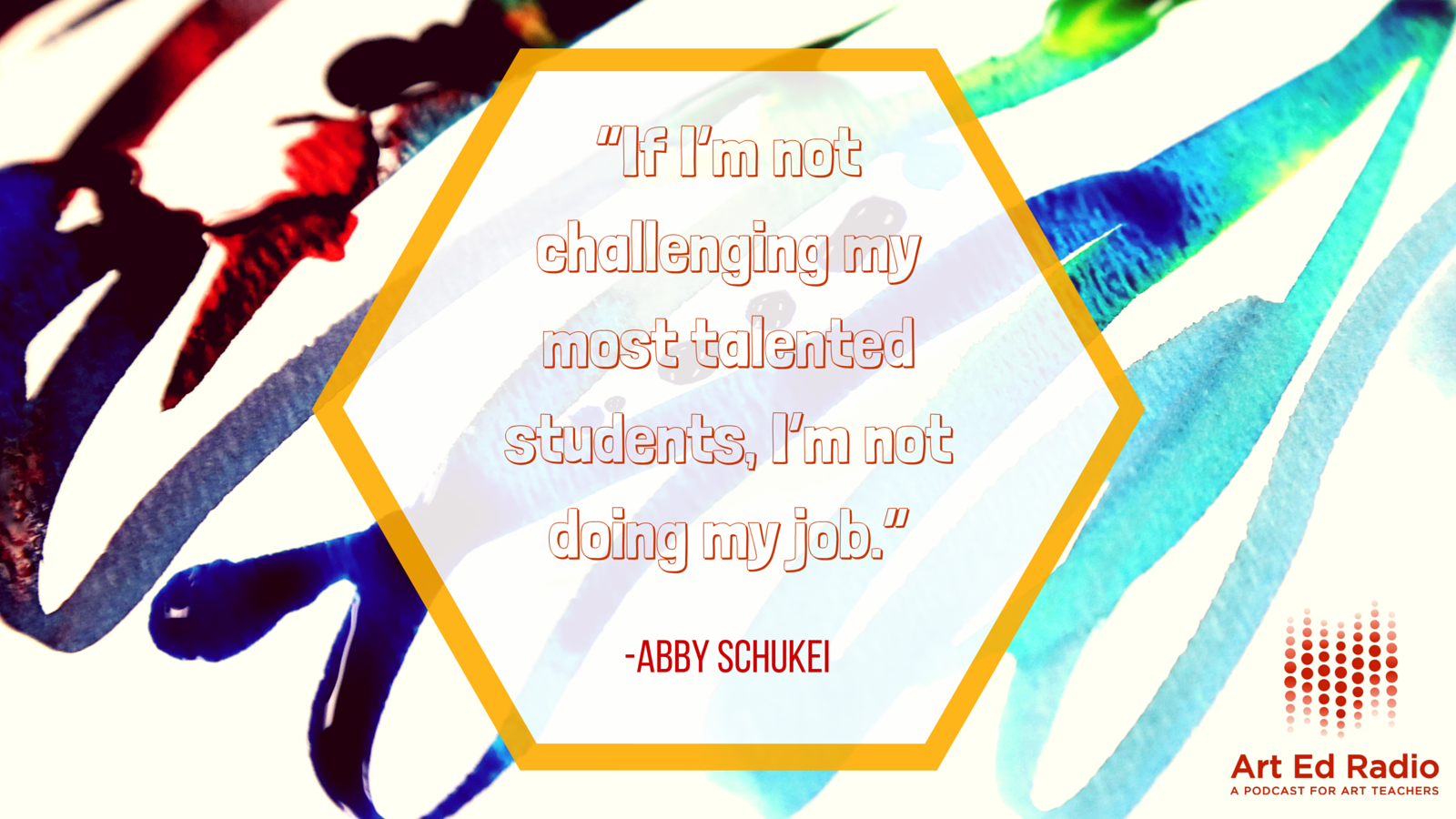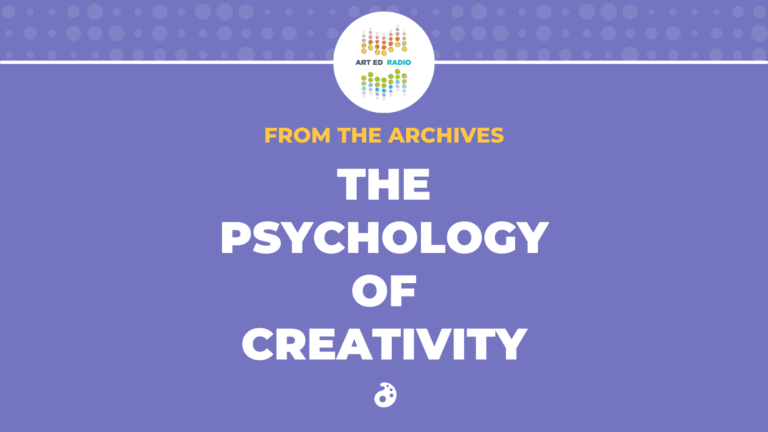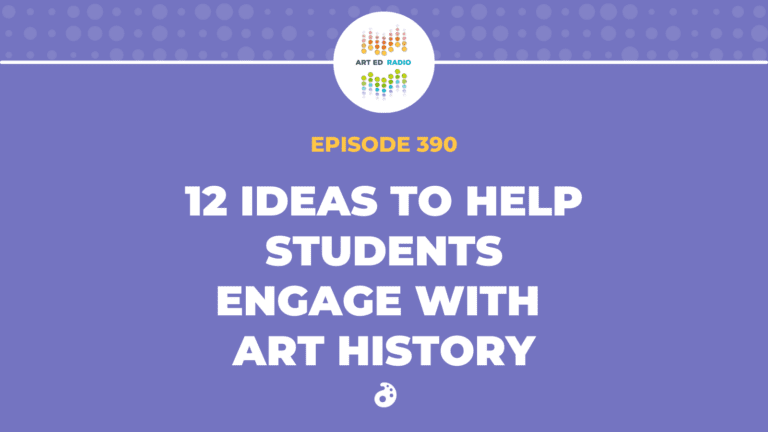Differentiation
From Talented to Terrible, Find Success Teaching Every Student (Ep. 002)
February 29, 2016
Art of Ed writer Abby Schukei joins Tim to share strategies to help every student find success, which encourages and empowers them to continue to create. They talk about Instagram and how social media allows us to move artwork beyond our classroom walls (10:00), and why Abby lets her worst-behaved students do whatever they want–within reason (19:00). Tim closes the show with some important thoughts on developing an authentic audience for our students to encourage their persistence and perseverance (21:00). Full Episode Transcript Below
Resources and Links:
Today’s Guest:
Abby Schukei, AOE Writer and 7th-8th grade art ed teacher in Omaha, Nebraska and the unofficial “Tie-Dyed Champion of America” ;).
Connect with Abby on Instagram, Twitter, or read her articles on AOE.

Transcript:
Tim Bogatz: Welcome to Art Ed Radio, the podcast for art teachers. This show is produced by The Art of Education and I’m your hose, Tim Bogatz.
Today’s episode is called From Talented to Terrible, Find Success Teaching Every Student. We’ll talk about what to do with our worst students, our best students, and everyone in between. Abby Schukei will join us later to talk about successful strategies for our classroom and why our students need an authentic audience for their work in order to help them find success, persevere, and continue to create. Before we get started today, I wanted to let you know that this episode is brought to you by The Art of Ed’s online course, Assessment in Art Education. I actually just taught this class last month and I love it. If you want to learn more about assessing the arts, this is a class for you to consider. We cover formative assessments, student growth, authentic assessment, and a lot more. You’re able to develop a huge variety of assessments that you can take back and use immediately in your classroom. The class is worth three credits and runs five weeks. All classes start on the first of each month and you can learn more by going to theartofed.com and clicking on the classes tab. Now, let’s get onto the show.
Some teachers really enjoy working with our most talented students. We can help them create great work and accomplish some wonderful things. Other teachers enjoy working with struggling students. We love to see growth and their accomplishments seem even more worthwhile when they’ve persevered to get there. In either case, we have extra responsibility if our students are going to be successful. Before we get into all of that though, I want to bring up this point. It is vital, above all else, to give our students the attention they both need and deserve.
One of the things that really brought this home to me is a documentary that I watched called Painting in the Dark by Adam Westbrook, which deals with the idea of whether we still create when no one is watching. Do we persevere if there is no audience, because nobody wants to make art in a vacuum. Van Gogh, for example, painted for nine years for an audience of exactly one person, his brother Theo. Imagine the art you make is only ever going to be seen by a single person, are you still going to create? Are you still going to persevere? Are you still going to make art?
If you think about it, we do that to our worst students. We hang up the best work, but as for the worst, we see it as the teacher, we give it back to our student, and who knows where it goes from there. If we’re the only one that looks at it, does that encourage your kids to keep working, or to keep creating, or does that confidence and persistence we want to build begin to slip away? It’s something we need to consider when we talk about the strategies that we use with our students.
Now, to start thinking about some of those strategies, I want to talk about an article that I wrote last year called I Have the Next Picasso in my Art Room, Now What? Basically what we’re looking at there is your kids that are incredibly gifted or incredibly talented in the arts. What do you do with them? Basically it comes down to continuing to give them opportunities that challenge them. One of the points I bring up in the article was talking about how a lot of strategies that regular education teachers use, classroom teachers use, or even gifted teachers use also apply to those kids in the art room. A lot of those same strategies will work. Acceleration, for example. You can let kids move through your curriculum at a little bit faster pace allowing them to skip what they already know.
As a teacher it would be your job to match your teaching to what your gifted student is interested in, and what they’re ready for, and what they’re motivated to do. You can also compact by letting kids reduce the amount of repetition they need. They don’t need exercises to develop the skills that they already have. You can be looking for enrichment activities, things they can do at home, drawing challenges, all of that. It doesn’t need to be more work, but you want to give them the opportunity to develop skills and develop concepts in which they’re interested in.
As far as students who are struggling it’s kind of the same thing. We need to find the right level for that challenge, whether it’s scaffolding, helping develop skills, or just working one-on-one with them to help develop what they need. It’s paramount that we give them the opportunity to meet that challenge. Along the way, I’ve found it’s really important to celebrate every success because kids who are struggling, they need to persevere and if you can give them that motivation by celebrating even the smallest things that they’re doing right, the smallest building blocks that you can work with, they’re going to be much more inclined to work harder when the time comes.
The other thing is you need to still make sure those kids who are struggling have work that’s enjoyable for them. Not everything has to be about skills. You can do abstract work, you can do non-objective work, expressive works, cartoonings. Find things that are fun. Find that balance so that you’re not always setting kids up for a struggle. Let art be enjoyable. I’m also kind of interested in talking about students who are both talented and terrible, but we’re going to hold that thought for just a second because it’s time to bring on our guest.
My guest is an AOE writer, an award winning blogger, a former elementary, and current middle school art teacher, and the tie dye champion of North America. Abby Schukei, how are you?
Abby Schukei: You know, I’m doing pretty awesome. I just finished up a batch of tie dye tonight, I saw the sun today, so I’d say it’s a top ten day for sure.
Tim Bogatz: There you go, life is good. You’ve been writing for AOE for all of about two months now. How is that going for you and do you have a favorite article so far that you think everybody needs to check out?
Abby Schukei: Well, so far so good. I’m amazed at all of the behind the scenes things that are happening and I’m just really excited to be part of such an innovative resource for art teachers, but as far as my article that I’ve written so far, my first one is about the props in the art room. That one was one of those that I took a lap around my classroom, and looked at all the weird stuff I had, and I was like, “Oh, my gosh. How am I going to narrow this down?” We all got weird stuff, so that was kind of a fun one.
Tim Bogatz: Yeah, that’s a cool one. I think that’s a good one that a lot of people can relate to. The other one that I really liked was the one you had about incorporating movement into your classroom, because I think that’s something that a lot of teachers need to do more of.
Abby Schukei: Definitely.
Tim Bogatz: Anyway, we need to get to the subject at hand, our students who are talented and terrible. I talked in the introduction of the show about a documentary that I watched called Painting in the Dark. A lot of it is about the public response to our artwork, how we search for that public response. I have one question for you, but I kind of want you to look at it from a couple different angles. Both in our classrooms on a day to day basis, but then also as far as social media goes because I know you do a lot of that. How important is it for kids to be recognized for what they do, recognized for their artwork?
Abby Schukei: Whether it’s in the classroom or from social media, I think student recognition in the art room is huge. Looking at the classroom first, I think students are so impressionable and they’re constantly seeking peer approval that showcasing and displaying their work, not for just the art students to see, but an entire school, the teachers, that kind of provides a sense of accomplishment for them. Something that I do personally is no matter the project, I happen to have this space, but I display every single student’s artwork, even in my 7th and 8th graders. That’s something you typically only think of maybe doing in elementary school.
As a result of that, I have levels that vary as far as quality of work, but it provides an opportunity for everybody to see it. I can see people walking by the display case and they ask a question, or they stop and they want to know more about it, and they will hunt down the artist, and ask them a particular question. I think that’s something that students appreciate. It struck a chord with somebody else and they were able to be recognized for what they did. Going back to the quality of artwork being all ranges of it, it maybe might push those students that didn’t put enough time or effort into their work to have it with those students that did take the time, maybe it’ll push them to work a little harder next time. As far as social media goes, I know you being in the high school, it’s a big deal.
Tim Bogatz: Yeah, yeah, for sure. Instagram likes above all else.
Abby Schukei: Oh, my gosh. Yeah, so I think it’s just one of those things that if you’re able to share student artwork via social media, that almost speaks louder to them then on a more global level rather than just how many likes did I get rather than just it being in the school.
Tim Bogatz: I think that’s good and I think it kind of comes back to the point of searching for that authentic audience that goes beyond our classroom. Hanging work on our walls is good, but we can do so much better. If you have that display case, which obviously not every art teacher has that opportunity, but if you do, you need to take advantage of it and then when kids know that they have more of an audience, whether that be the teachers that are talking to them about the work or just their peers that are seeing it in the halls, I think that’s a really good thing for them. Like you said, it really serves as a motivating factor. Also like you said, the other big motivation is seeing their work on social media. I know you use both Twitter and Instagram. How much work do you put out there? Do you show a lot of your kids’ work on social media sites?
Abby Schukei: Yeah, I definitely do. For my students, they’re not really into Twitter as much as I am as an educator. It’s more for me professionally in a way. My venue for them is using Instagram. I actually have a school account that we use, and students follow, and it’s a big deal if their picture makes it on there. Even students that I don’t have in the art classroom are checking it out. Let’s say I’m posting a picture. Somebody else will see it, and they tag the other person in it, and so it becomes this big deal. Probably 90% of my students have an Instagram account. They want to be the one that makes it on there.
Tim Bogatz: Just kind of a quick aside here, none of my kids use Facebook because that’s for old people, but do you feel like Twitter’s going that way, too?
Abby Schukei: I kind of do. I mean, there’s a few of my students that have Twitter, 7th and 8th graders that have it, but if they have it, they don’t use it. They only use it to follow their Justin Bieber or whoever they’re [crosstalk 00:12:46]. I think that’s kind of going that way, too.
Tim Bogatz: I know, and I feel like it’s Instagram and Snapchat now. I’m afraid I’m getting old.
Abby Schukei: We are.
Tim Bogatz: Anyway, moving on from that. I want to talk kind of about what’s happening in the classroom and starting with the more talented kids. What are some of your favorite strategies for kids that are able to go above and beyond what you’re looking for? Let’s say you’re back in elementary and you’re teaching perspective to 4th grade. This kid can already draw three point perspective, and these great two point city scenes that go back forever, and whatever else. If you have a kid that can go above and beyond, what do you do for those kids that already know the content or already know the concepts that you’re teaching?
Abby Schukei: If they know a concept already, I got to find a way to challenge them. If I am not challenging them, I am not doing my job. The other day I had an 8th grader in one of my digital art classes. We were working on a project. A typical student, it take them five days to finish it, and it took him a day and a half. I have all this time and I’m like, “Oh, my gosh.” Right now it was just a basic of Photoshop kind of thing, trying to get familiar with it. In a situation like that when it’s easy for them, they’re not being challenged, I turn it around and I try to make it a teaching moment as far as, “Okay, can you share with the rest of the class something that you learned or an easier way that you found how to do something different from how I told you how to do it?” Kind of make him the teacher, like he’s the expert.
Sometimes that peer-to-peer teaching moment speaks louder than what I can do and so I create that opportunity for them. Now, I still have all this extra time with him and I ask him what he wants to do. What is something that you think is challenging to you and maybe he researches it. I find a way to help him with it because I have the time to have that one-on-one time with him, so find something that he’s interested and let’s figure out how to do it.
Tim Bogatz: Kind of speaking about that one-on-one thing, that’s a big strategy for me as far as kids who are struggling as well. If we started talking about the other side of the spectrum, kids who are really struggling, whether it be with drawing, sculpting, Photoshop, whatever, I’ve always found that they need a ton of reteaching and usually a lot of encouragement to go along with it just because they do get down on themselves when they’re struggling. I know there are a lot of teachers out there that just have so many kids that they see in a day, so many classes they have, and they don’t have that one-on-one time necessarily with all the other demands of their job, but for you, what works well for you with kids that are struggling with whatever that concept may be?
Abby Schukei: If you can give that one-on-one time, that’s going to be the best thing for them, but that’s not ideal in all situations. For me, it’s really about simplifying it and breaking it down. Unfortunately for most students, if they’re struggling with something it’s usually drawing. That’s kind of the basis of what we do. For those students, even if we’re not doing a grid type of drawing assignment, maybe I have pre-made grids for them to help them get started. Maybe we take the upside-down man drawing technique and maybe I actually break down whatever image they’re working from or we create something that they can reference to in that upside-down man method.
Then another thing is I think it’s really important to think about the concept that’s being taught. Let’s say it’s a project about color and the student’s really struggling with the drawing portion of it, is it important that he makes the drawing as accurate and perfect as he can or at the end of the day, am I just looking to see that they know and understand the concept of color? I think at the end of the day it’s looking to see the improvement, no matter how minimal it is, and just to make them feel successful by using some of those small, little techniques of simplifying.
Tim Bogatz: I think even with those kids who may not get that end result that you want, they’re still kind of meeting the challenge that you put out in front of them. I think it kind of goes back to something that Andrew and I talked about on the podcast last week. Andrew use the analogy of weight lifting. Everybody’s lifting a different weight, and some kids might be doing these huge exercises, and other kids are just doing a little bit, but everybody’s challenged. I think as long as you can find that challenge for each of your kids, that’s where they’re going to be successful.
Abby Schukei: Yes, definitely.
Tim Bogatz: Then I think this is probably going to be the last question here. I kind of hinted at this in my introduction, but it’s something I kind of want to talk about. The other thing that I’m really interested in is what about the kid who’s both talented and terrible? I’m not talking like terrible skill-wise, but more behavior-wise. They can draw, they can create, they can sculpt like nothing else, but with that originality and that creativity comes with a refusal or defiance to make the stuff that you want them to make. Where do you go with a kid like that?
Abby Schukei: About five different kids popped into my mind right there and those stubborn students are challenging. You don’t want to stifle them by any means, but it can be difficult. I think sometimes you got to do a little bartering. You got to find that middle. What can you compromise with? In situations like that, I’m so open to students. If they want to present something to me, if they say, “Hey, I’m going to do this. It’s still going along with what we’re talking about,” and they can prove that to me, that’s great.
My rule of thumb that I go for with my students is if at any point another student, teacher, or administrator walks into my classroom, that student should be able to fully explain in detail what they are doing. Not just, “Oh, hey. I’m painting this picture of a shark in a tornado for a while,” but they have to say, “This is what I’m doing. This is the learning target.” If they’re not able to do that, then that’s the point where we have to revisit and say, “What are you doing here? I gave you this freedom to challenge you.” Take it from there.
Tim Bogatz: I think that responsibility needs to be a part of that as well, but more importantly, did you just drop a Sharknado reference?
Abby Schukei: I totally did because it just happened last week.
Tim Bogatz: That’s awesome. I think that’s a good note to go out on actually, but Abby, thank you very much for joining us tonight. I really enjoy talking to you and you’ve definitely given us some good insight, so thank you.
Abby Schukei: Yeah, thanks for having me.
Tim Bogatz: Just one other thing I want to talk about before we close this show out. Abby and I finished by talking about the students that are both talented and terrible, and kind of what we do with them. They have that talent, but don’t necessarily fit into your regular curriculum or they don’t want to do things you’re asking them to do. For me, I think it’s kind of a balancing act. Abby talked about the negotiation process and letting them do what they can or do what they want to do as long as they can justify it. I’m fine with that. I always let my kids do their own thing if they can explain the what and the why of what they’re proposing, especially if they already knows the concepts that I’ll be covering. It’s so much better to let them work through their own thing than forcing them to sit through and give half of an effort on work that they don’t want to do.
It really is about finding that balance of what kids want to do versus what you need them to do. It’s very much about being able to adapt and being flexible as an art teacher. Really, both our talented and our terrible students come with some needs. Those are different, undoubtedly, but it all comes down to this. We as teachers have a responsibility to share with each and every one of our students our time, our opinions, and our expertise. We can’t be the only ones. Kids need that authentic audience that we talked about, the audience that goes beyond the classroom walls.
It kind of goes back to Westbrook’s Painting in the Dark documentary. That authentic audience can take any number of forms, but the things that you do in your classroom inspire students to achieve. The audience you provide them with encourages them to continue creating and to continue persevering. Our ultimate goal, what we really want to do, is ignite that passion for learning in all of our students, whether they are talented or terrible. That passion will help them create and reach for a level that’s somewhere beyond where they are right now. We can get them where we want them to be, we just can’t expect them to do that in the dark.
Art Ed Radio is developed, produced, and supported by The Art of Education with audio engineering by Michael Crocker. If you want to support the show and enjoy what we’re doing, please subscribe on iTunes, like the show, and leave a comment. You can find additional content under the podcast tab on theartofed.com where I’ll have the write up of this episode with links, quotes, and resources you can use in your classroom. New episodes are released every Tuesday and I’ll be back next week with Andrew McCormick talking about the projects that define your art program.
Magazine articles and podcasts are opinions of professional education contributors and do not necessarily represent the position of the Art of Education University (AOEU) or its academic offerings. Contributors use terms in the way they are most often talked about in the scope of their educational experiences.



